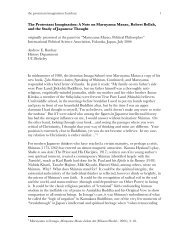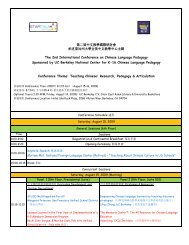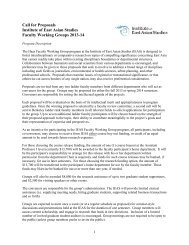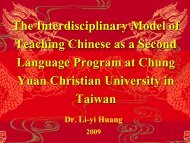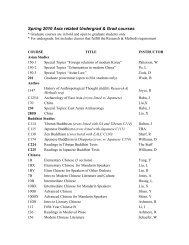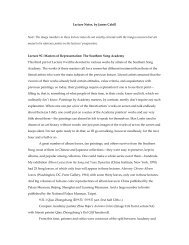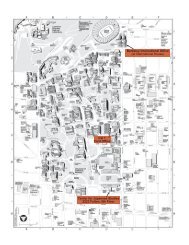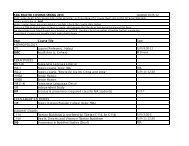Third Edition Spring 2013 - Institute of East Asian Studies, UC ...
Third Edition Spring 2013 - Institute of East Asian Studies, UC ...
Third Edition Spring 2013 - Institute of East Asian Studies, UC ...
You also want an ePaper? Increase the reach of your titles
YUMPU automatically turns print PDFs into web optimized ePapers that Google loves.
new Meiji government turned on the sangha. However, this was notthe sole reason, as Nativist scholars sought to expel Buddhism asa “foreign” influence (because <strong>of</strong> its Chinese origin) while raisingShintoism (seen as a proper “native” Japanese religion) to greaterheights. The entire construction <strong>of</strong> the new religion <strong>of</strong> “state Shinto”is beyond the scope <strong>of</strong> this paper, but Jaffe and other authorshave covered this extensively. It is sufficient to note that for thepurposes <strong>of</strong> constructing a new “Japanese” national identity, leaders<strong>of</strong> the Meiji government felt it important to construct an all-inclusivereligious identity that united the people under a single banner.Shintoism, with its supposed connection to the imperial linestretching back to the mythological beginnings <strong>of</strong> Japanese history,was the perfect candidate to take the place <strong>of</strong> Buddhism.Because <strong>of</strong> the push to marginalize Buddhism, the religionfound itself under attack from the state rather than being supportedby it. The Meiji government quickly did away with the templeregistration system, severing the main connection Buddhist leadershad day-to-day government administration. Instead, the newcentral bureaucracy implemented a new citizen registration systemknown as the koseki ( 戸 籍 ,literally “housedoor registration”),while the place <strong>of</strong> registration moved from Buddhist temples toShinto shrines under the purview <strong>of</strong> the new bureaucracy. TheMeiji government did not stop with the removal <strong>of</strong> the Buddhist’spower over the census; in addition, the new government passeda law eliminating the special registry for Buddhist priests, forcingthem to register under the new koseki system as commoners (oras nobles, according to their previous class status). In essence, thegovernment engaged in a campaign <strong>of</strong> forced laicization againstthe Buddhist clergy. Buddhist clerics became liable for carrying aprotection charm from their local Shinto shrine marking them asa citizen. They became susceptible to the military draft. They alsolost their Buddhist names gained in ordination. By the time theMeiji government had completed these tasks, the only thing legallyseparating a monk from a commoner was his affiliation with a particularsect. 18As if the forced laicization <strong>of</strong> monks were not a severe18 Jaffe p. 95enough blow to traditional Buddhist orders, shortly after theforced laicization <strong>of</strong> monks, in 1872 the government issued a proclamationdeclaring that nikujikisaitai was not only legal, and thusno longer subject to harsh punishments, but it encouraged monksaround the country to marry. This caused a massive uproar withinthe Buddhist hierarchy and many sect leaders spent long periods<strong>of</strong> time in Tokyo pleading with the government to rescind theorder. 19 While the government did bend slightly to accommodatesectarian desires, complete cancelation <strong>of</strong> the order was not forthcoming.The Meiji leaders at the Ministry <strong>of</strong> Doctrine saw sectarianrestrictions on marriage as backward, and in their race to showWestern powers that they were a modern nation, vigorously encouragedclerical couplings.The reader is likely to be amazed at what appears to be acomplete 180-degree turn in Japanese Buddhism’s fortunes. Whileduring the Edo period the sangha was a protected and cherishedmember <strong>of</strong> the state’s order, the Meiji government cast Buddhismout and forced numerous changes upon the sangha that did notappear to be in its best religious interests. Instead <strong>of</strong> helping policethe sangha, as it had in the past, the state endeavored to changeand even destroy it. In fact, at some points the state actually preventedthe sangha from policing itself, citing the national interestin modernization. 20Without the state’s support <strong>of</strong> the sectarian code <strong>of</strong> disciplineit enjoyed in the Edo period, clerical marriage spread inexorablythrough the ranks <strong>of</strong> the Buddhist priesthood. Sect leaderscould do little more than issue proclamations and watch helplesslyas the number <strong>of</strong> temple families living openly increased. In time,the conversation about clerical marriage changed from the needto eliminate it as an evil, to a conversation centered on what theBuddhist sects could do to recognize and care for the pitiable state<strong>of</strong> temple families. By the year 1900, there were calls not only fromnew Buddhist lay organizations to encourage, and in some casesdemand marriage, but there were also internal pressures fromwithin Buddhist sects to integrate temple families into Buddhist19 Jaffe p. 14820 Jaffe p. 15297 Robert Bowers Curl Laicization in Japanese Buddhism 98




